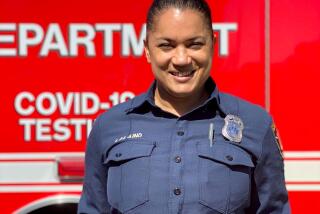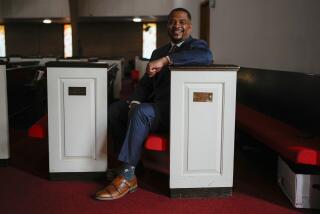Racial Slurs a Prank or for Real?
CHICAGO — A series of racial slurs broadcast recently over the Chicago Fire Department’s radio frequencies have sparked a political debate here, and officials are determined to find out who is behind them.
Since Feb. 2, there have been at least six such transmissions, including one Wednesday. Fire department officials said some, but not all, of the slurs were aimed at African Americans.
Mayor Richard M. Daley has urged firefighters to name names, insisting they should not protect the identities of “these cowards.”
And City Council members, who this week condemned the actions, have called for reforms to end what some describe as a long-standing culture of racism in the department.
Yet city and fire officials acknowledge that they don’t know whether these slurs all were uttered by firefighters -- or whether outsiders hacked into the radio frequency used by the department. “One [incident] is real,” said Molly Sullivan, a fire department spokeswoman. “One, we believe, is a prank by someone who’s thumbing their nose at the city administration. The rest, we’re still looking into.”
The first reported slur is the only one that officials have confirmed involved firefighters.
While inside a fire truck, an unidentified firefighter was heard making derogatory comments about the driver of a vehicle with Wisconsin plates.
The firefighter spent several minutes discussing the motorist, including calling the person an “[expletive] Cheesehead,” officials said. The firefighter didn’t know the radio’s microphone was on. An unidentified fire department lieutenant in the cab of the truck at the time did not do anything to stop it.
The firefighter was given a 90-day suspension without pay and transferred out of his firehouse -- which was in a predominantly black neighborhood. The lieutenant, who rotates through various firehouses, was given a 30-day suspension without pay.
Fire department officials declined to identify either employee, saying that union contract rules prohibited them from naming anyone who was under investigation. The incident is part of a larger probe by the fire department’s internal investigation into the racial slurs.
Fire Commissioner James Joyce, who described the remarks as reprehensible, said: “The recent problems and behaviors we have seen are totally unacceptable to me.” Last week, he said that “offenses like these will be fireable offenses.”
Amid all this, two black alderman said they had received threatening phone calls -- and a fire battalion chief reportedly got a death threat -- over their public criticism of the department.
Chicago police are investigating a mailed threat that Fire Battalion Chief Nicholas Russell, president of the African American Fire Fighters League of Chicago, received last week. It talked about a battalion chief being shot and “found in a shallow grave,” according to police sources and a report in the Chicago Sun-Times.
Racial discord has plagued this city’s fire department for years, prompting repeated promises to hire and promote more minorities, provide diversity training and take a stronger stance against racism.
In 1997, a videotape was given to the media that showed firefighters drinking, dropping their pants and uttering racial slurs during a 1990 firehouse retirement party. Seven of those on the tape were fired, and 22 others were disciplined. But the seven later sued the city to get their jobs back. In 2002, they were reinstated with full seniority by an arbitrator handling the case, fire department officials said.
In 1998, a group of black firefighter candidates sued the city, claiming that the department’s written entrance exams and selection process were biased against minorities. The case is under review in federal court.
And in 2002, Jim McNally, president of the Chicago Fire Fighters Union Local No. 2, acknowledged that it had been “inappropriate” to protest against affirmative action by going to a firehouse in blackface, as he had done in the 1980s.
This week, he condemned the recent spate of slurs. If they were pranks, either by firefighters or outsiders, McNally said, “To characterize those capable of such childish actions as ‘pea-brained’ would denigrate the intellectual capacity of plant life.”
Officials with the city’s Office of Emergency Management and Communications are investigating each incident, trying to determine which city-issued radio was used or whether the transmissions came from elsewhere.
Chicago’s fire department has 675 radios that are assigned to specific trucks and vehicles, 875 portable radios for officers and firehouses, and 325 radios for paramedics and other emergency medical service teams.
When such radios are used, the transmissions go out across radio-frequency waves. The Federal Communications Commission splits up the radio spectrum, devoting some parts to emergency personnel and others for commercial and other uses.
But when the circumstances are right, the lines of division can blur and allow open access to what is supposed to be a frequency for police and fire department personnel alone.
That has happened repeatedly in Southern California.
In 1999, a radio hacker posing as an officer warned of shots fired near the Brea City Hall, prompting police to evacuate portions of the civic center and seal off surrounding streets as they combed the area for a possible gunman. There was none.
That December, police departments in Huntington Beach and Westminster launched separate investigations into complaints that racial slurs had been used over a police radio frequency as officers hunted for suspects in a bank robbery. The departments’ internal affairs teams concluded that the slurs likely were made by off-duty police officers with access to radios or by amateur radio operators hacking into the police frequency.
Each radio used by Chicago’s emergency personnel is programmed with a specific numeric identifier, said EMC spokesman Larry Langford. Like a telephone number being spotted on caller ID, a radio’s identifying number can be tracked with a transmission.
The city has been able to identify some of the codes for the radios used in the racial slurs, Langford said.
More to Read
Sign up for Essential California
The most important California stories and recommendations in your inbox every morning.
You may occasionally receive promotional content from the Los Angeles Times.









